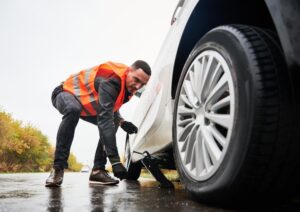Winter is a captivating season but it poses some difficulties and risks for drivers. The presence of snow, ice, sleet and fog can significantly impact visibility, traction and overall control on the roads. According to the National Highway Traffic Safety Administration (NHTSA) there were 374 fatal accidents and an estimated 25,000 injury crashes caused by wintry conditions in the United States during 2020 alone. To avoid becoming another statistic it’s important to prepare yourself and your vehicle for winter driving while also adhering to some essential safety guidelines whenever you venture out onto the roads. In this article we will provide you with a set of driving tips specifically designed for winter conditions that will help ensure your safety and instill confidence every time you take the wheel.
Prepare your vehicle for winter driving
Before heading out in winter weather it’s important to ensure that your vehicle is in working order and ready for the chilly conditions. Here are a few essential steps you should follow to get your vehicle prepared for winter driving;
Replace your wipers
When your wipers become worn out it can affect your ability to see clearly and result in smudges, chatter or skipping on the windshield. To ensure performance it is recommended to replace your wipers every six to twelve months or earlier if you notice any signs of wear or damage. Additionally it’s advisable to use winter washer fluid that helps prevent freezing and effectively cleans off dirt, mud and salt residue from the glass.
Check your tires
Your tires play a role in ensuring your safety and stability while driving. It’s essential to check the tread and pressure of your tires to maintain optimal performance. Take a few moments every month to assess the tire pressure and adjust it according to the manufacturer’s guidelines. Additionally inspect the depth of your tire treads for any signs of wear or damage. While the legal minimum tread depth is 2/32 inch experts recommend having at least 6/32 inch for safe driving in winter conditions. To measure this simply insert a penny into the tire groove with Lincoln’s head facing downward; if you can see the top of his head it indicates that your tires are worn out and need replacement. It would also be wise to consider using winter tires or all season tires designed specifically for traction and performance, in weather conditions.
Check your battery
Your battery can lose power in low temperatures, making it harder to start your car or run the electrical systems. You should test your battery before winter and replace it if it’s weak or old. You should also keep your battery terminals clean and tight and avoid leaving any accessories on when the engine is off.
Check your fluids
It’s important to maintain the fluid levels in your vehicle to ensure optimal engine performance and prevent any issues like overheating or freezing. Regularly. Fill up the oil, coolant, brake fluid, transmission fluid and power steering fluid as needed. Additionally make sure to use the type and grade of fluids recommended for your specific vehicle. Don’t forget to follow the manufacturer’s schedule, for changes as well.
Check your lights
It is important to have functioning lights on your vehicle to ensure visibility, in foggy weather conditions. Make sure to check and maintain your headlights, tail lights brake lights turn signals, fog lights and emergency flashers. Additionally remember to keep your lights clean and promptly replace any bulbs that have burnt out.
Drive safely in winter weather

Even if your vehicle is well prepared for winter driving, you still need to drive carefully and cautiously in wintry conditions. Here are some tips for driving safely in winter weather:
Slow down
Driving at a speed is crucial, during winter to ensure your reaction time isn’t compromised and to allow for a longer stopping distance. It’s important to adjust your speed based on road conditions, traffic and weather. Additionally it’s advisable to maintain a distance of at least eight to 10 seconds providing ample space and time to stop safely in case the vehicle ahead suddenly applies brakes.
Avoid using cruise control
Using cruise control during journeys can offer convenience but it can pose risks on slippery roads. When relying on cruise control you may face difficulties in adjusting your speed or braking promptly when necessary. Moreover if your wheels start spinning or skidding cruise control can lead to loss of traction and diminished control. It is advisable to refrain from utilizing cruise control in wintry conditions and rely on foot pedal operation instead.
Steer in the direction of a skid
If your car begins to slide on ice or snow it’s important not to panic or abruptly hit the brakes. Instead gently steer in the direction as the rear of your vehicle is sliding, allowing your wheels to align with the intended path. Additionally ease off the accelerator. Avoid any sudden maneuvers that could exacerbate the skid. Once you regain traction you can straighten your wheels. Continue driving as usual.
Don’t crowd a snow plow
Snow plows play a role in ensuring road safety by clearing the way for drivers. However it’s important to be mindful of risks when driving near them or attempting to overtake. Snow plows are slow moving vehicles that can obstruct visibility and may spray snow or debris onto your windshield. Additionally they might make stops, turns or lane changes that can take you by surprise. It is advisable to maintain a distance behind a snow plow and exercise caution while overtaking. Remember never to pass a snow plow on the side as this is where they push the accumulated snow.
Be alert and well rested
Driving during the winter can be. Overwhelming, so it’s important to stay alert and well rested before getting behind the wheel. If you’re feeling drowsy or influenced by alcohol or drugs it’s best to avoid driving. Also make sure you minimize distractions such as your phone, radio or passengers and keep your attention on the road and your surroundings.. Of course don’t forget to buckle up for safety reasons and ensure that your passengers do the same.
What to do in an emergency
If you encounter an emergency while driving in winter weather, such as getting stuck in snow or being involved in a crash, you need to stay calm and follow some steps to protect yourself and your passengers. Here are some tips for what to do in an emergency:
Stay with your car
If you find yourself stranded or unable to move during winter conditions it’s best to stay inside your car rather than exert yourself by attempting to push or dig it out. Your vehicle can serve as a shelter keeping you warm and protected from the weather and other vehicles. Additionally if you have a working cell phone with a signal it’s important to reach out for assistance and inform someone of your whereabouts and the situation you are in.
Let your car be seen
If you are stopped or stalled in wintry weather, you need to make sure that other drivers can see your car and avoid hitting it. You should put bright markers on the antenna or windows and keep the interior dome light on. You should also turn on your hazard lights and raise the hood of your car if it’s not snowing.
Be mindful of carbon monoxide poisoning
If you find yourself stranded and in need of running your engine for warmth it’s essential to be aware of the risk of carbon monoxide poisoning. Carbon monoxide, an odorless gas can accumulate in your vehicle. Lead to symptoms such as headaches, fatigue, nausea or even death. To ensure safety make sure to keep your car’s exhaust pipe free from snow and ice. It is advisable to run the engine continuously. If necessary, open a window to allow air circulation. Remember never to run the engine indoors.
Conclusion
Driving during the winter season can present difficulties and hazards. It can also be a delightful and satisfying experience if you take the necessary precautions. To ensure your vehicle is well prepared for winter conditions and to drive with confidence and safety, in wintry weather it’s important to follow these tips. Additionally, being aware of what actions to take during an emergency will help minimize the chances of accidents, injuries or mechanical failures. Embracing these practices will allow you to fully appreciate the beauty and enjoyment that winter can offer.




